SailNav. Search

SailNav. Help Index
Navigating the App - Getting Started
Welcome aboard! SailNav is your offline navigation tool, designed to ensure reliable operation in areas without coverage or internet.
It is intended as a primary solution for smaller boats without instrumentation or as an essential backup system for any size of boat, whether power or sail. For fishermen and sailors: Plan your trip and return to port with complete autonomy.
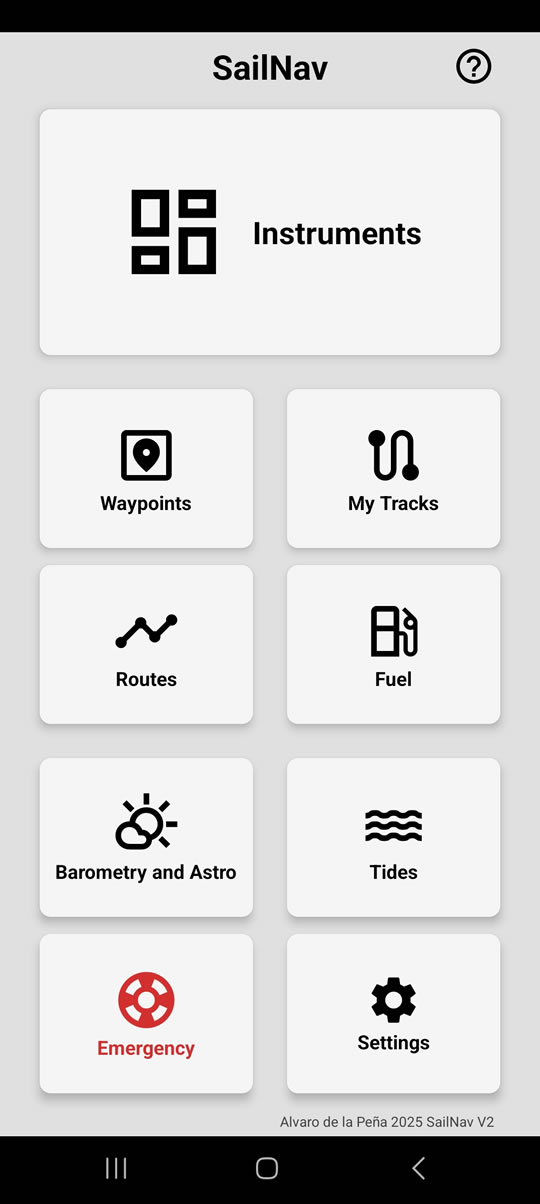
Initial Setup: Preparing for the Voyage
Before you start, go to the Settings menu to customize your experience. Here you can define the language, your boat's measurement units, engine data, alarms, and interface colors.
It is also highly recommended to configure the Emergency section with local rescue and assistance phone numbers, as well as personalized help messages.
Keep in mind that on some devices, emergency calls may be available even without a GSM/SIM card (*).
With everything ready, you will be prepared to make the most of SailNav and enjoy safe and reliable navigation.
Instruments
The Instruments section is composed of four different screens:
- Map and Routes → The initial screen when entering this section. View maps and define Routes and waypoints.
- Navigation → Compass and navigation/waypoint data.
- Instruments 1 → A configurable panel that allows you to fully customize which metrics, indicators, or navigation data you want to see on screen.
- Instruments 2 → A second configurable panel, same as the previous one.

To move between screens, there are two methods:
- Swipe sideways with your finger (horizontal scroll).
- Use the bottom navigation buttons (left/right arrow).
To exit the Instruments section and return to the main menu or the previous screen, you can use:
- The Android system's back button.
- The back button on the top bar (arrow to the left of the title).
Alarms and Top Buttons
The top bar gives you quick access to the most important safety functions and alarms.

To activate an alarm (MOB, Anchor, Heading), simply press its icon. It will turn red to indicate it is active. To deactivate it, press it again, and it will turn gray.
- MOB (Man Overboard / Mark Position): Its main function is to mark the exact GPS position in a "man overboard" emergency. You can also use it to quickly mark any point you need to return to.
- Anchor Alarm: Activates anchor drag monitoring. If your boat moves beyond the safety radius you have defined in Settings, an alarm will sound.
- Heading Alarm: Alerts you if you deviate from your navigation course beyond the tolerance degrees you have set in Settings.
- Help Button (?): Gives you direct access to this help guide at any time.
- Fuel Indicator: Shows the remaining fuel level. The color changes from blue to red as the level drops, alerting you visually. You can configure the details in the Fuel section.
Note on Alarm Volume
Important! For the alarms to sound, two conditions must be met: the application's alarm volume (configured in Settings) must be enabled, and your device's media volume must also be at an audible level.
Maps and Routes
This is SailNav's main navigation screen. From here you can view your position, course, and speed in real-time, but its true potential lies in planning and following routes, recording points of interest or fishing spots, etc...
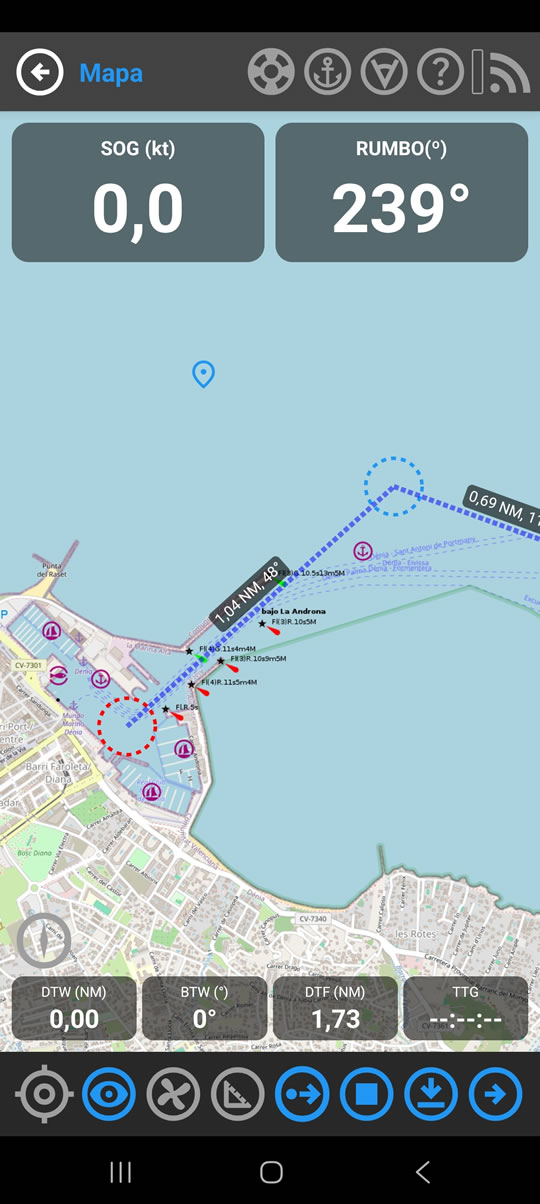
Screen Anatomy
- Top Panels: Show your current SOG (Speed Over Ground) and HEADING. You can hide and show them with the corresponding button on the bottom bar.
- Interactive Map: The main area where you view your position (the boat icon), saved waypoints, and the routes you create. You can pinch to zoom and drag to explore.
- Bottom Panels: These activate when navigating a route and display key data:
- DTW (Distance to Waypoint): Distance to the next point on the route.
- BTW (Bearing to Waypoint): The course you should take to reach the next point.
- DTF (Distance to Finish): Total remaining distance to the end of the route.
- ETA (Estimated Time of Arrival): Estimated time of arrival at the final destination.
- Bottom Toolbar: Contains all the actions to manage the map and routes.
Creating and Editing Routes
Creating a route in SailNav is an intuitive and flexible process. You don't need to enter a separate editor; you do everything directly on the map.
Create a New Route
- Add the first point: Make a single tap on the map where you want to start your route or where your first destination is. There is a bottom button that defines whether the route's origin is the boat (the default) or the first marked point. This feature allows creating routes from land in advance.
- Add more points: Continue tapping on the map to add as many points as you need (up to a maximum of 12). The route line will be drawn automatically. The route points will be blue, except for the active waypoint, which will be red.
- Navigation activated!: As soon as you add the first point, route navigation is activated, and the bottom panels (DTW, BTW...) will show the information for that point.
When you approach a point, the app will automatically advance to the next one, updating all navigation data.
Modify an Active Route
- Move a point: Press and hold a point on the route and, without releasing, drag it to its new position.
- Insert an intermediate point: Make a single tap on the route line, between two existing points. A new point will be inserted at that position.
- Delete a point: Make a single tap directly on the point you want to delete.
Saved Waypoints
In addition to temporary route points, you can create permanent Waypoints (your home port, a cove, a fishing spot...).
- Create a Waypoint: Make a long press anywhere on the map. A screen will open for you to give it a name and save the point permanently.
- Use a Waypoint in your route:
- Tap a saved Waypoint's icon to see its information card.
- Perform a long press on that card to add the Waypoint to the end of your current route.
Bottom Toolbar
Each icon gives you quick control over a specific map function.

- Center Map: Centers the map on your boat's current position and activates tracking. The icon turns blue when tracking is active.
- Route Origin: Toggles the starting point of the route. By default (blue), the origin is your boat. If you tap it, the origin becomes the first point you marked manually.
- Show/Hide Track: Activates or deactivates the display of the line that draws the path your boat has taken (your track).
- Measurement Mode: Activates a tool to quickly measure the distance and bearing between two points (A and B) without creating a route.
- Hide Top Panels: Shows or hides the SOG and HEADING indicators.
- Stop Route: Cancels and deletes the active route you are navigating.
- Save Route: Saves the route you have created on the map so you can load it in future navigations.
- Next Screen: Slides to the Navigation screen.
Configurable Instrument Panels
SailNav offers you two fully customizable instrument screens: Instruments 1 and Instruments 2. The idea is that you can dedicate each screen to a different type of information, organized to your liking (headings, times, racing, cruising, fishing, fuel, sail, or motor).
Each panel is a grid that you can design as you wish, displaying up to 24 different metrics per screen. Between the two panels, you can have up to 48 indicators at your fingertips!

How to Configure a Panel
From the Instruments 1 or 2 screen, follow these steps:
- Press the gear icon in the bottom toolbar.
- The "Panel Configuration" window will open for you to design the structure.

- Rows: The panel is organized by rows. Add new ones with "ADD ROW" or remove them with (X).
- Indicators: In each row, choose how many data points you want to display (from 1 to 4).
- Size (S, M, L): Assign a size to each indicator: Small (S), Medium (M), or Large (L).
How to Select Data
With your grid created, tap on one of the empty boxes. A list of all available metrics will be displayed for you to choose which one to show in that space.
Index of Available Metrics
Here is a summary of all the data you can add to your panels, organized by category:
| Metric | Abbreviation | Description |
|---|---|---|
| Speed and Heading | ||
| Speed Over Ground | SOG | Your actual speed over the seabed. |
| Course Over Ground | COG | Your actual course over the seabed. |
| Magnetic Heading | HEADING | The magnetic heading your boat's bow is pointing to. |
| Maximum Speed | MAX | The maximum speed you have reached on the current trip. |
| Average Speed | AVG | The average speed of your current trip. |
| Route Navigation | ||
| Active Waypoint | WAYPOINT | Shows the active waypoint number and the total for the route (e.g., "1 (3)"). |
| Distance to Waypoint | DTW | The distance remaining to reach the next waypoint. |
| Distance to Finish | DTF | The distance remaining to reach the final point of the route. |
| Bearing to Waypoint | BTW | The course you should take to head directly to the next waypoint. |
| Time to Go | TTG | The time remaining to reach your final destination. |
| Estimated Time of Arrival | ETA | The estimated time of arrival at your final destination. |
| ETA at Waypoint | ETA-W | The estimated time of arrival at your next waypoint. |
| Time to Waypoint | TTW | The time remaining to reach your next waypoint. |
| Current Time | CURRENT TIME | Displays the device's current time. |
| Performance (VMG) | ||
| Velocity Made Good | VMG | Your effective speed of approach to the destination. |
| VMG Efficiency | VMG % | The performance of your VMG to measure your sailing efficiency. |
| Fuel and Engine | ||
| Fuel Bar | FUEL LEVEL BAR | A visual bar showing the remaining fuel level. |
| Fuel Percentage | FUEL % | The percentage of fuel remaining in the tank. |
| Fuel Volume | FUEL VOL | The amount of fuel remaining (e.g., in liters). |
| Range (Distance) | FUEL (DIST) | The estimated range in distance with the remaining fuel. |
| Range (Time) | FUEL (TIME) | The estimated range in time with the remaining fuel at the current speed. |
| Theoretical Consumption | FUEL CONS (THEO) | The theoretical consumption of your engine as configured in Fuel. |
| Real Consumption | FUEL CONS (REAL) | The real-time instantaneous consumption of your engine. |
| Fuel Efficiency | FUEL EFFIC | Fuel efficiency (e.g., miles/liter), to find your optimal cruising speed. |
| Trip Data | ||
| Distance Traveled | DIST | The total distance traveled on the current trip. |
| Trip Time | TIM | The timer for the current trip. |
| Visual Instruments | ||
| Heel | HEEL | An inclinometer that shows the heel angle of your boat. |
| Mini Map | MAP | A small map view centered on your position. |
| Mini Compass | COMPASS | A compass rose with your heading and the bearing to the waypoint. |
Bottom Toolbar
This control bar allows you to manage the recording of your trip, control the engine, and move between screens.

- Left Arrow: Returns to the Navigation screen.
- Play: Starts or resumes the trip recording.
- Engine ON/OFF: Press this button to record when you turn the engine on or off. This is key for the app to calculate consumption and range. The icon lights up in blue when the engine is ON.
- Pause: Pauses the recording.
- Save: Saves the recorded trip in My Tracks.
- Stop: Stops the recording and resets the data.
- Settings (Gear): Opens the window to customize the grid of this panel.
- Right Arrow: Advances to the Instruments 2 screen (from Instruments 1) or returns to the map (from Instruments 2).
Waypoints
A waypoint is an individual geographic point that you save because it has a special interest for you: your home port, your favorite destination, a cove, a fishing area, a dangerous rock, etc.
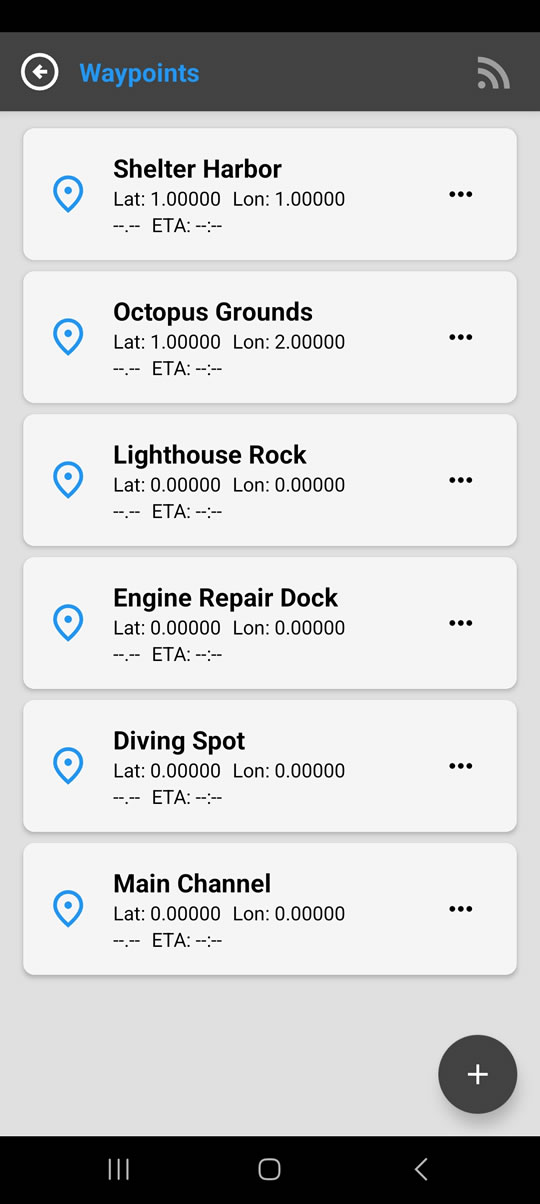
How to Create a Waypoint
There are two ways to add a new waypoint to your list:
- From the Map: Make a long press on the exact point on the map you want to save.
- Manually: Press the floating (+) button to enter a name and its coordinates, or use your current location.
How to Use Your Waypoints
- Navigate to a Waypoint ("Go to"): Tap any waypoint in the list to activate direct navigation to it.
- Add to a Route: On the Map, saved waypoints appear with their own icon. You can tap them and add them to a route.
- Manage Waypoints: Press the (...) icon to Edit the waypoint's information or Delete it.
Routes
This section is your personal route library. All the journeys you have created from the Map are saved here, allowing you to have your recurring trips, port approaches, or favorite fishing routes at hand.
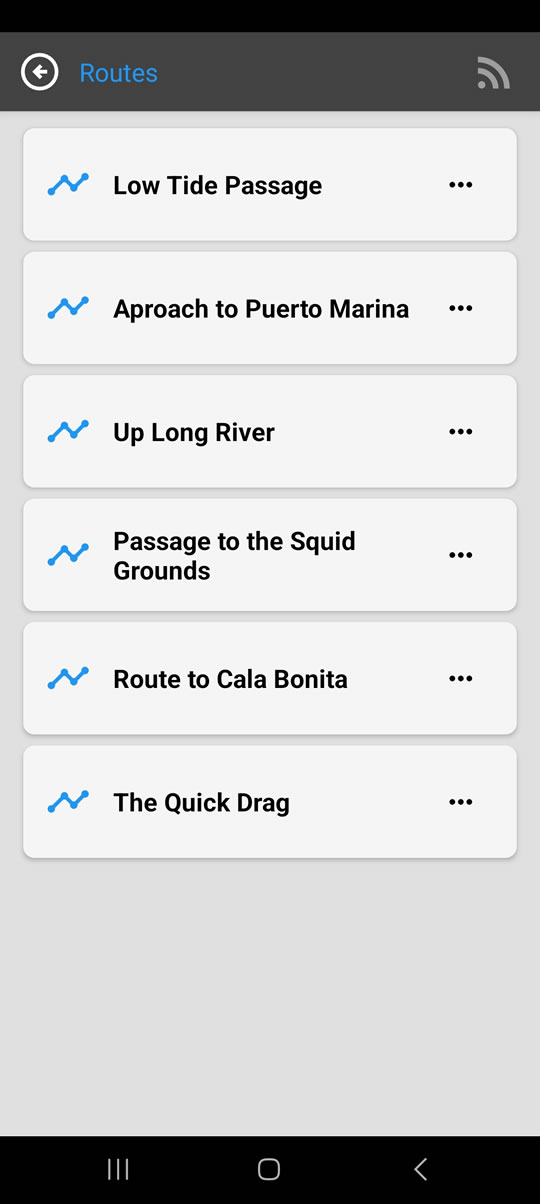
What can you do here?
- Load a Route: Tap on a route to load it onto the map and start navigating it.
- Manage your Routes: Press the (...) icon to open a menu with more options, such as Rename or Delete.
Usage Tips
- Save the approach route to your home port to navigate it safely at night or in bad weather.
- Had an amazing fishing day? Save the route with a name like "Dorado Trolling Sep." to repeat it.
My Saved Tracks
This section is your digital navigation logbook. The history of all the trips you have recorded is saved here, allowing you to analyze and relive your navigations with an unprecedented level of detail.
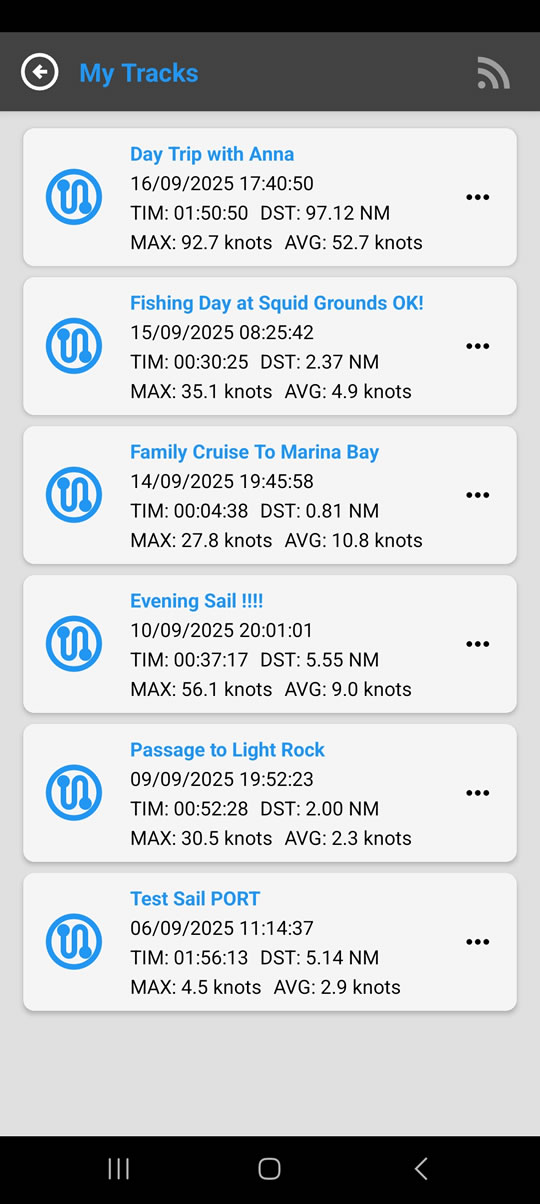
Key Difference: Routes vs. Tracks
It's very simple: Routes are the plan (future) and Tracks are the record of what you have done (past). You design a Route to follow it, while a Track is the automatic recording of the journey you have actually made.
Analysis of a Saved Track
When you tap on one of the tracks in the list, a detailed analysis screen opens where you can:
- Visualize the Journey: See the exact track you followed, drawn on a map and differentiating between sail and motor.
- Manage the Track: Change the name of the saved track or delete it permanently.
- Consult Detailed Statistics: The app automatically breaks down the metrics of your trip, differentiating the segments you did under sail from those you did with the engine. For each mode (sail and motor) you will be able to see:
- The total usage time.
- The distance covered.
- The average speed.
- The maximum speed reached.
Fuel and Engine
This section is your control center for fuel management. Its goal is to provide an estimate of consumption and remaining fuel level, especially useful for boats that do not have a physical level gauge, and as a verification system for those that do.
Through very simple questions about refueling and internal algorithms that combine your engine's data (configured in Settings) and the actual usage you record with the Engine ON/OFF button, SailNav can predict your range and help you decide if you need to refuel before reaching your destination.

Main Indicators
- LEVEL (%): The estimated percentage of fuel remaining in your tank.
- FUEL (L): The estimated amount of fuel remaining in liters.
- DTF (NM): The distance you have left to reach the end of your active route.
- EFF (NM/L): Your current fuel efficiency, measured in nautical miles per liter. It helps you find the most economical cruising speed.
- RANGE (NM): The estimated range in distance you can travel with the remaining fuel.
- REAL (L/h): The actual hourly consumption of your engine under current conditions.
- RANGE (H): The estimated range in time if you maintain the current engine speed.
- THEOR. (L/h): The theoretical hourly consumption of your engine, based on the data you entered in the settings.
Fuel History
This table shows a record of your operations: refuelings, resets, and the calculated consumption for each leg, allowing you to keep a detailed control.
Low Level Alarm
For your safety, the application will automatically activate a sound and visual alarm when the estimated fuel level drops below 17%.
Bottom Toolbar

- Play / Pause / Stop / Save: Controls for recording your trip, which work the same as in the other screens.
- Engine ON/OFF: The key button of this section. Press it to tell the app when you turn the engine on and off. It is essential that you record its use for the calculations to be accurate.
- Settings (Gear): Takes you to Settings so you can enter or modify your engine and tank data.
- Refueling History: Opens a screen where you can view and manage all your refueling history.
DISCLAIMER: All metrics in this section are theoretical estimates. Their accuracy depends directly on the correct configuration of your engine's data and the disciplined recording of engine use and refueling, as well as the specific conditions of the sea state and the boat and engine themselves. SailNav is not responsible for decisions made based on this information. The skipper is solely responsible for the safety and proper management of fuel on board.
Barometry and Astronomical Information
This section offers you data on atmospheric pressure to anticipate changes in the weather, as well as detailed information about the sun and moon.
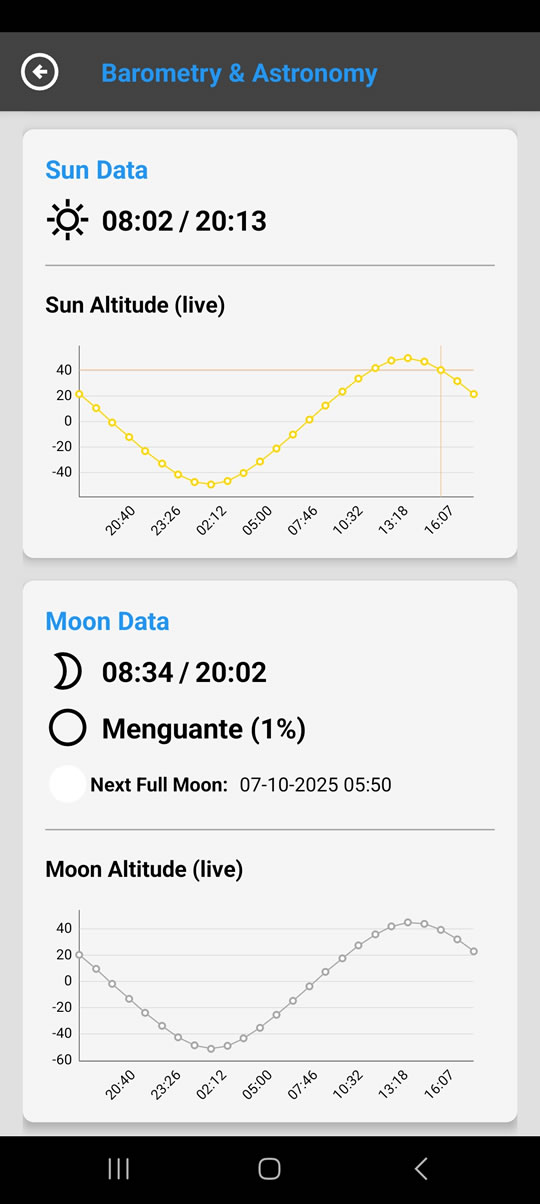
Barometric Pressure
A sharp drop in pressure usually indicates the arrival of bad weather. Note: This feature requires your device to have a built-in barometric sensor.
Sun and Moon Data
You will find the sunrise and sunset times, moonrise and moonset times, the current moon phase, and the date of the next full moon, along with graphs of their altitude.
Upcoming Improvements
We are working to improve this section and will soon include a complete Tides section!
Tides
This section provides you with a graphical tide prediction for any point you select on the map, an essential tool for planning port entries, anchorages, or fishing trips. Keep in mind that as this is an application that does not require internet access, the data provided is approximate and for informational purposes only. Always consult official tide tables and local nautical charts.
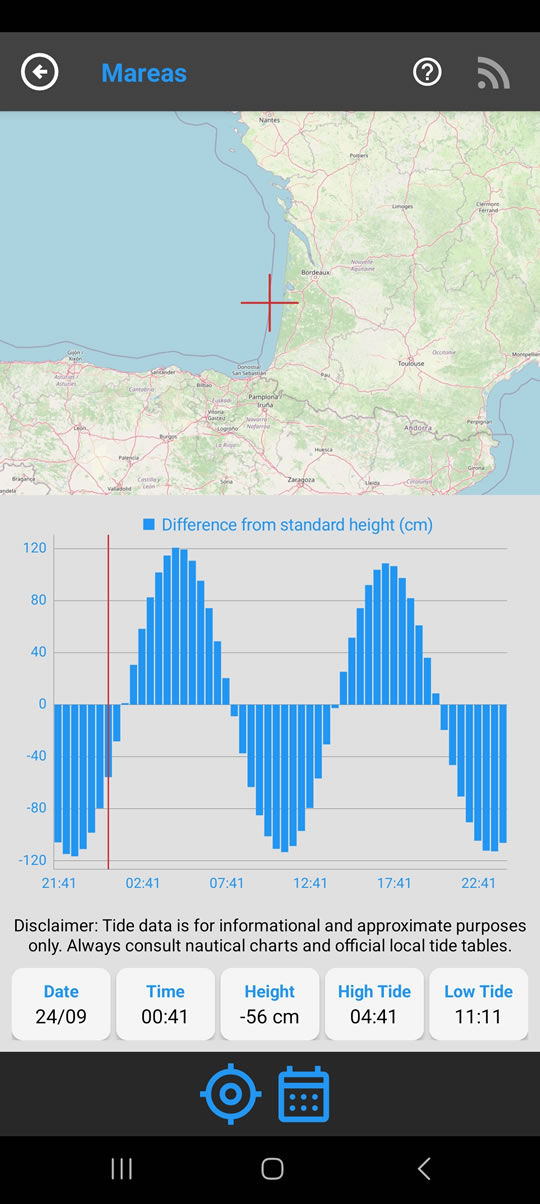
How It Works
- Select a Point: Tap directly on the map. The red cross will indicate the selected point, and the bottom chart will update with the tide prediction for that location.
- Tide Chart: Shows the variation in tide height throughout the day. The vertical red line indicates the current time.
- Key Data: In the bottom panels, you can see the date and time of the chart, with the difference from the current standard, and the time of the next high and low tide.
Toolbar

- My Position (GPS): Press this button to get the tide prediction for your current location.
- Calendar: Allows you to select a future date to check tide predictions for other days.
Disclaimer: Tide data is approximate and for informational purposes only. Always consult official tide tables and local nautical charts.
Safety Center (Emergency)
This section gives you quick access to the most important tools in a critical situation. Set it up before you set sail!
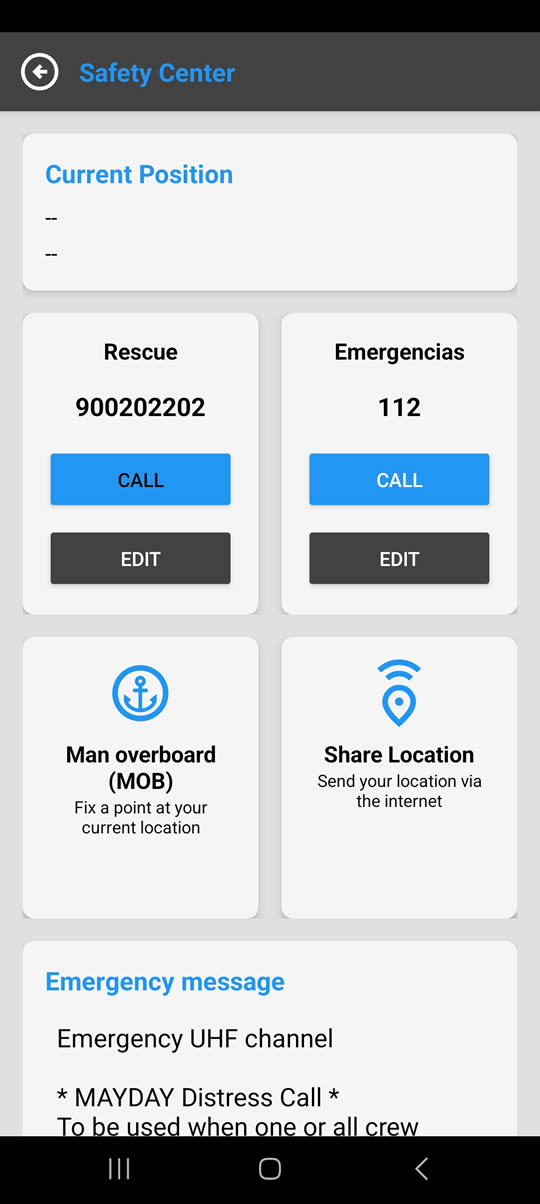
Available Functions
- Current Position: Displays your exact GPS coordinates to communicate to rescue services.
- Emergency Calls: Direct call buttons to Maritime Rescue (editable) and 112.
- Man Overboard (MOB): Instantly marks the GPS position of the incident and activates direct navigation to that point.
- Share Location: Send your position to a contact via WhatsApp, SMS, etc. (requires connection).
- Emergency Message: Editable template for a distress call (MAYDAY, PAN-PAN, SECURITÉ) by VHF radio.
Settings
From here you can customize and configure the behavior of SailNav to perfectly suit your needs and those of your boat.
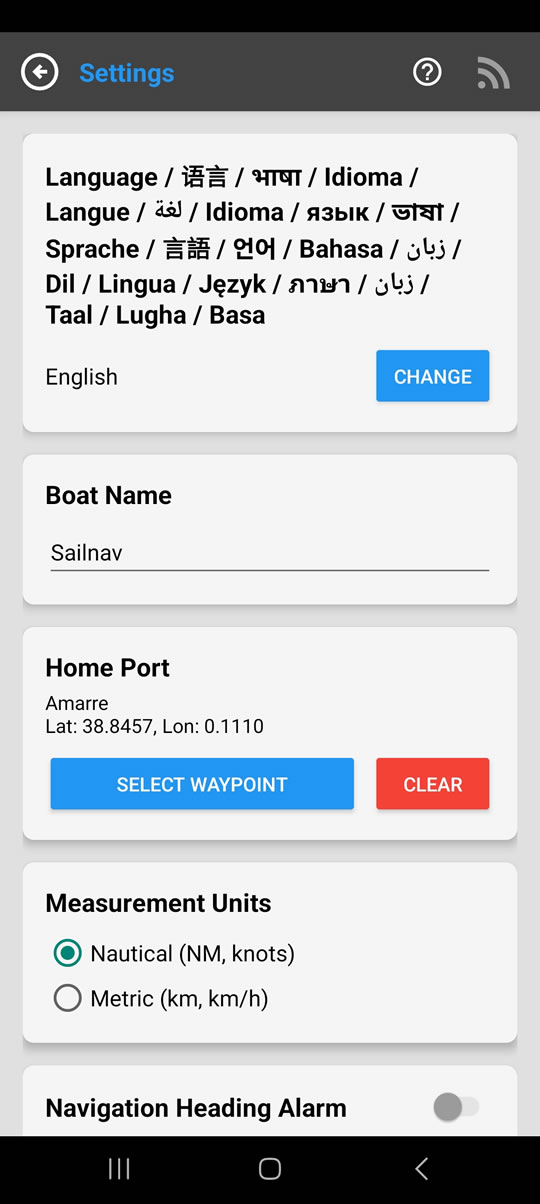
Configuration Options
- Language: Change the language of the entire application.
- Boat Name: Enter the name of your vessel.
- Engine and Fuel: A crucial section for the app to estimate consumption. Here you must enter key data such as your tank capacity and the consumption curves of your engine at different speeds.
- Home Port: Assign a saved Waypoint as your home port.
- Units of Measurement: Choose between Nautical units (knots, miles) or Metric units (km/h, km).
- Heading Alarm: Define the tolerance in degrees for the visual aid in the Navigation screen.
- Anchor Alarm: Enter the distance in meters for the radius of the anchor drag alarm.
- Alarm Volume: Adjust the volume of all application alarms.
- Screen Mode: Manually force the visual theme to Day or Night mode.
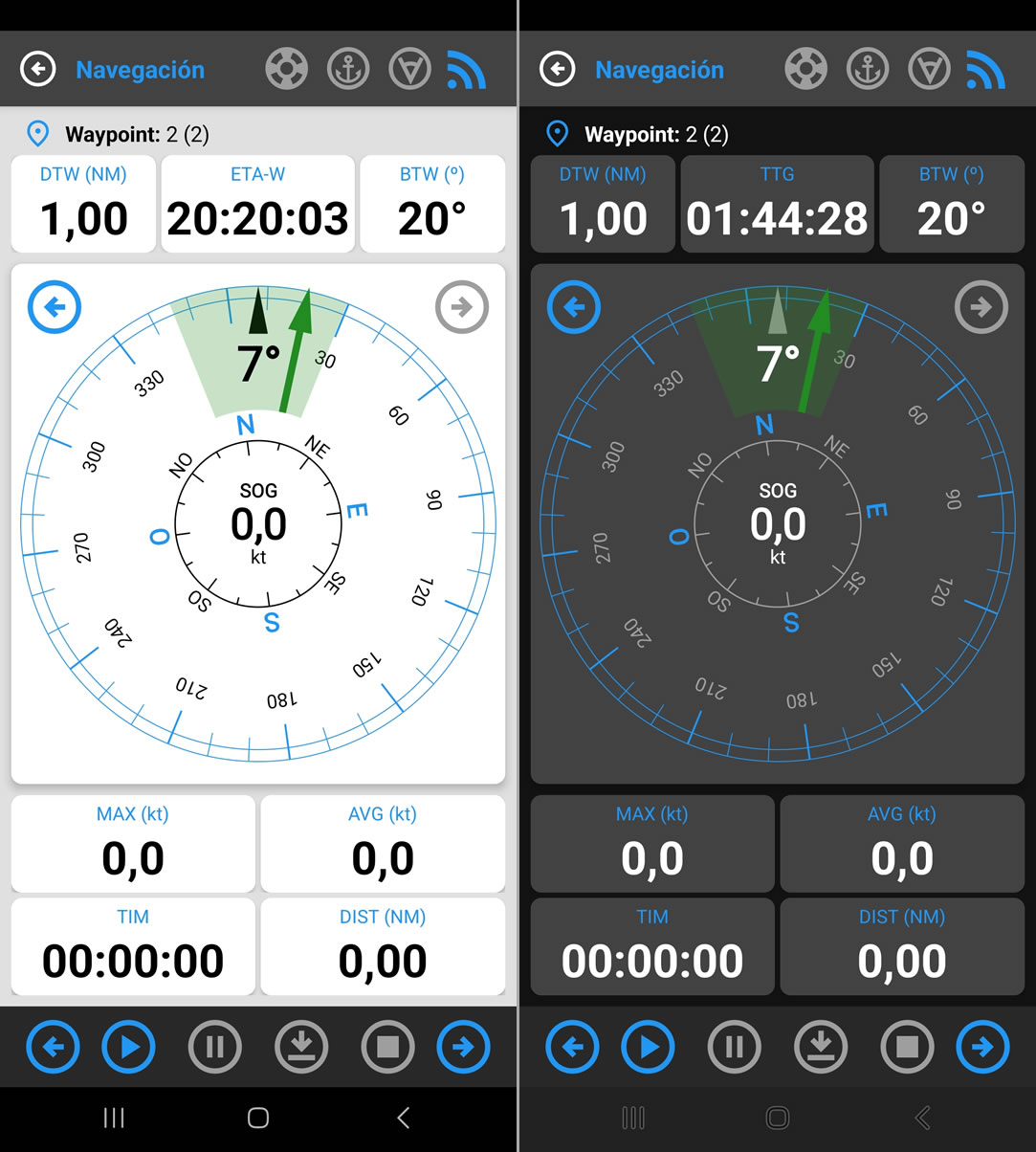
GPS and Compass Information
This is the diagnostic panel for your device's sensors, useful for verifying the quality of the GPS signal and the calibration of the compass.
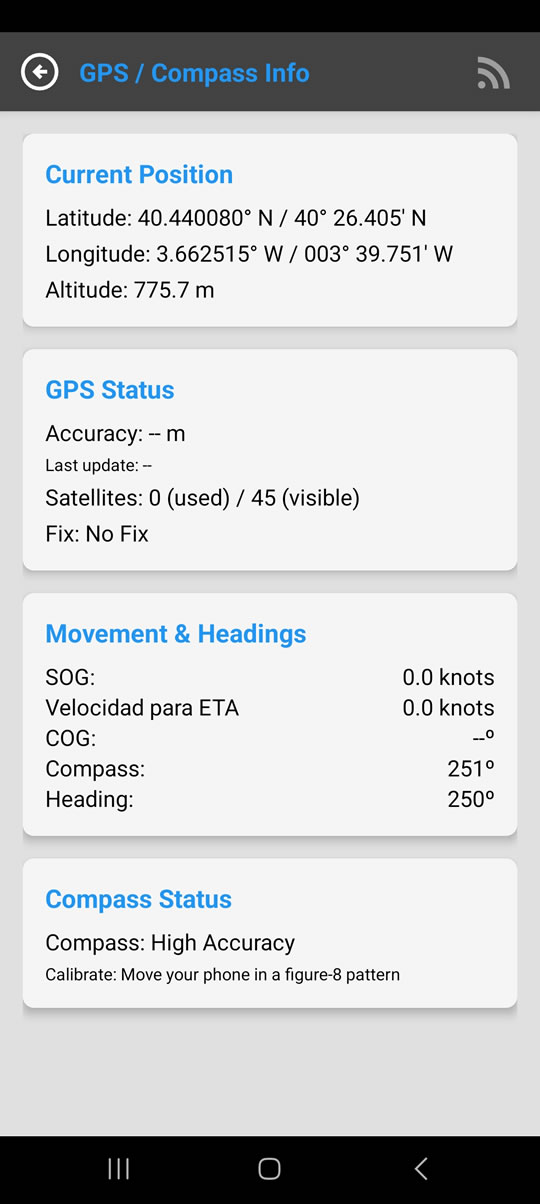
GPS Status
- Satellites (used / visible): The more satellites in use, the more accurate your position will be.
- Accuracy: The margin of error of your position in meters (a lower number is better).
Compass Status
If the accuracy is low, the app will prompt you to calibrate the compass, usually by moving the phone in the air drawing a "figure 8".
Buoys and Marks (IALA)
Buoys and marks are aids to navigation that indicate channels, dangers, special areas, and safe water references. Their meaning is interpreted by shape, colors/bands, topmark (figure at the top), and light characteristics (if they are lit).
IALA Zones
The world is divided into two regions for lateral buoyage. The way to interpret port/starboard changes between them (the other types—cardinal, isolated danger, safe water, special—are common):
- Region A: Europe, Africa, most of Asia, Australia, and New Zealand — see Region A table.
- Region B: The Americas (North, Central, and South), Japan, Korea, Philippines — see Region B table.
Key difference in lateral channel marks: in Region A port = red, starboard = green; in Region B it's the opposite: port = green, starboard = red.
Main Types of Marks
- Lateral (channels): indicate the port/starboard side of the entrance channel.
- Cardinal: locate the danger relative to the cardinal points (N, E, S, W).
- Isolated Danger: a danger surrounded by navigable waters.
- Safe Water: channel centerline / reference point; navigable waters all around.
- Special: areas or uses (reserve, anchorage, cables, races, etc.).
Lights are described with abbreviations (e.g., Fl for flashing, Oc for occulting, Q for quick, etc.)
and patterns (colors/periods). The topmark reinforces the type (e.g., stacked cones on cardinals).
| IALA A Buoyage | |
|---|---|
| Mark | Meaning |
 |
Port Lateral (red, can/cylindrical shape): Leave the buoy to your port when entering the harbor (upstream). |
 |
Starboard Lateral (green, conical shape): Leave the buoy to your starboard when entering the harbor. |
 |
Bifurcation — preferred channel to starboard: Follow the starboard branch (red body with a green band). |
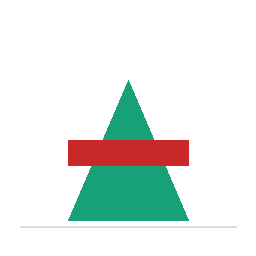 |
Bifurcation — preferred channel to port: Follow the port branch (green body with a red band). |
 |
Safe Water: Channel centerline / route axis. Red/white vertical stripes; spherical topmark. |
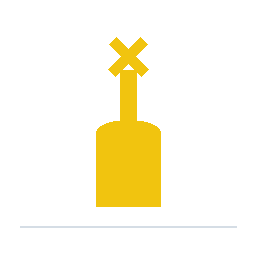 |
Special Mark (yellow): Special areas or uses (anchorage, recreational channels, restrictions, etc.). |
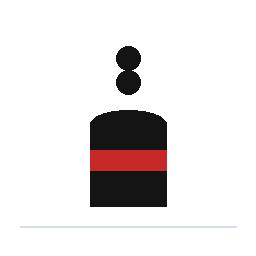 |
Isolated Danger: Localized obstacle; black with a red band; topmark two black spheres. |
 |
North Cardinal: Black over yellow; topmark ↑ ↑. Pass to the North. |
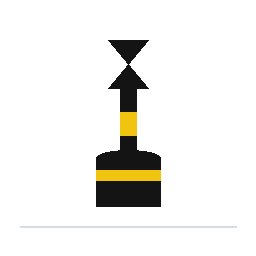 |
East Cardinal: Black-yellow-black; topmark ↑ ↓. Pass to the East. |
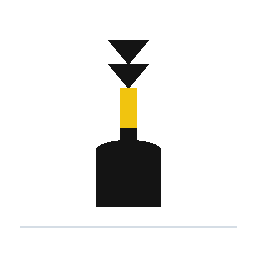 |
South Cardinal: Yellow over black; topmark ↓ ↓. Pass to the South. |
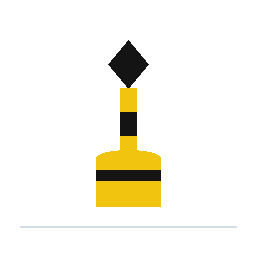 |
West Cardinal: Yellow-black-yellow; topmark ↓ ↑. Pass to the West. |
Region B (IALA)
In Region B, lateral marks reverse colors compared to A: port = green, starboard = red. This applies in all of the Americas (North, Central, and South; Caribbean), and also in Japan, Korea, and the Philippines. If you are sailing outside these areas, consult Region A.
| IALA B Buoyage | |
|---|---|
| Mark | Meaning |
 |
Port Lateral (green, can): Leave the buoy to your port when entering the harbor. |
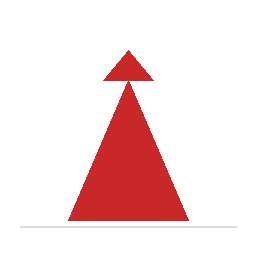 |
Starboard Lateral (red, conical): Leave the buoy to your starboard when entering the harbor. |
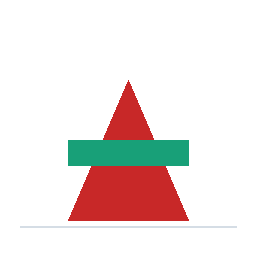 |
Bifurcation — preferred channel to starboard: Follow the starboard branch (red body with a green band). |
 |
Bifurcation — preferred channel to port: Follow the port branch (green body with a red band). |
 |
Safe Water (red/white, sphere). Same in A and B. |
 |
Special Mark (yellow). Same in A and B. |
 |
Isolated Danger (black with red band, two spheres). Same in A and B. |
 |
Cardinals N/E/S/W: same in A and B (black/yellow colors and cone-shaped topmarks). |
Lighthouse Lights
On charts, each lighthouse has a code that describes how it shines to be identified at night. The legend indicates the light type, color, period, and sometimes the height and range.
Typical format: Type (group) Color Period Height Range.
Example: Fl(3) W 10s 15m 12M = group of 3 flashes (Fl(3)), white (W),
10s period, 15m height, 12-mile range.
- Common types:
Flflashing,LFllong-flashing,Ococculting,Isoisophase,Q/VQquick / very quick,MoMorse code (e.g.,Mo(A)). - Colors:
Wwhite,Rred,Ggreen,Yyellow. - Sectors: on the chart, you will see red/green/white arcs indicating from where each color is visible.
| Lighthouse Lights (chart characteristics) | |
|---|---|
| Icon | Meaning |
 |
F (Fixed): continuous light. Ex: F W (fixed white). |
 |
Fl (Flashing): brief on, longer off. Ex: Fl W 5s. |
 |
LFl (Long-flashing): flash of ≥2s. Ex: LFl W 10s. |
 |
Oc (Occulting): on most of the time, with brief offs. Ex: Oc G 6s. |
 |
Iso (Isophase): equal time on and off. Ex: Iso Y 4s. |
 |
Q (Quick): rapid flashes (~1/s). VQ = very quick. |
 |
VQ (Very Quick): faster than Q. Ex: VQ(3) 10s. |
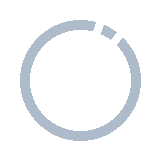 |
Fl(2): group of 2 flashes per period. Ex: Fl(2) W 10s. |
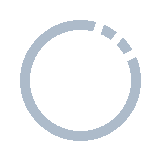 |
Fl(3): group of 3 flashes per period. Ex: Fl(3) W 15s. |
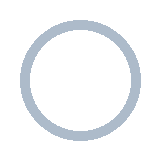 |
Mo(A): Morse code for the indicated letter. Ex: Mo(A) W 6s. |
 |
WRG Sectors: different colors depending on your bearing (W=white, R=red, G=green). Ex: Fl WRG 10s. |
Sectors: many lighthouses show R/G/W sectors with bearings/angles. On a chart, colored fans are drawn with limits in true degrees.
Chart Symbols
Quick reference based on INT/INT1 (IHO) symbology. Styles may vary slightly depending on the publisher. On many charts, soundings are usually in meters with decimals.
Soundings and Seabed
| Icon | Meaning |
|---|---|
| Sounding (depth) — in meters (e.g., 7.4 m). On some old charts: feet/fathoms. | |
| Depth contour/isobath — line of equal depth (label in meters). | |
| Nature of the seabed — abbreviations: S (sand), M (mud), R (rock), Sh (shells), G (gravel), Co (cobbles), St (stone). |
Dangers and Obstructions
| Icon | Meaning |
|---|---|
| Rock awash (danger at the surface). | |
| Submerged rock with known sounding (e.g., 2.1 m). | |
| Dangerous wreck — uncovered, or covered with little water (see sounding label if it exists). | |
| Obstruction / Doubtful sounding — generic symbol when the nature is not known with certainty. | |
| Submarine pipeline/cable — avoid anchoring/dragging gear. |
Aids to Navigation (symbols)
| Icon | Meaning |
|---|---|
| Lighthouse (may include light sectors). | |
Light notation — Fl(3) 10s 15m 12M = group of 3 flashes every 10s,
height 15m above reference level, range 12 miles.
|
|
| Leading line/range — a line to be aligned with marks to follow a safe course. | |
| Isolated danger — marked with an isolated danger mark; navigable waters all around. | |
| Safe water — a mark indicating navigable waters in all sectors. |
Zones and Restrictions
| Icon | Meaning |
|---|---|
| Prohibited/restricted area — do not enter (check legend/NOTMAR for details). | |
| Anchorage area — permitted/limited according to the label. | |
| Outfall/discharge — area to avoid (anchoring/fishing with gear is prohibited). |
Currents and Tides
| Icon | Meaning |
|---|---|
| Current — direction (true) and speed in kn (sometimes per tidal hours). | |
| Tides (references) — points with height/time data (see chart notes and tide tables). |
Tip: combine this section with IALA Buoys and Lighthouse Lights. For recent changes: check Notices to Mariners (NOTMAR).
Navigation Lights on Vessels
Navigation lights allow you to see and be seen, and to identify the type and relative heading of a vessel between sunset and sunrise, or in reduced visibility.
Basic set (according to COLREGs):
- Masthead light — white,
225°sector forward (112.5° on each side). Power-driven vessels only. - Sidelights — red on the port side and green on the starboard side,
112.5°sector each (visible from ahead to 22.5° abaft the beam). - Sternlight — white,
135°sector aft. - All-round light — light visible through
360°(white/red/green/yellow depending on the situation).
Common cases:
- Sailboat (under sail): only sidelights + sternlight. Optional tricolor at the masthead (vessels < 20 m) or separate red/green lights + white sternlight.
- Sailboat with engine: considered power-driven ⇒ adds masthead light (and by day, an "apex down" cone).
- Towing: yellow sternlight in addition to the white one; additional lights depending on the length of the tow.
- Fishing/trawling: combinations "red over white" / "green over white" (depending on the gear) + sidelights/sternlight.
- Not Under Command (NUC): red over red (360°) + sidelights/sternlight if making way.
- Restricted in Ability to Maneuver (RAM): red-white-red (360°).
- Pilot vessel: white over red (360°).
Luminous ranges vary with length (e.g., < 12 m ≈ 2–3 NM; larger vessels have greater range). On charts, colored sectors of lighthouses may be shown; on vessels, the sectors are fixed by regulation.
| Navigation Lights – Vessels (COLREG) | |
|---|---|
| Icon | Meaning |
 |
Masthead (white, 225°) — forward light to 22.5° abaft the beam on each side. |
| Port sidelight (red, 112.5°). | |
| Starboard sidelight (green, 112.5°). | |
| Sternlight (white, 135°). | |
| All-round (360° white): at anchor (<50 m: 1 forward; ≥50 m: 1 forward + 1 lower aft). | |
|
|
Not Under Command (NUC): two all-round red lights (if making way, also sidelights/sternlight). |
|
|
Restricted in Ability to Maneuver (RAM): red / white / red all-round (plus own lights if applicable). |
|
|
Constrained by Draft (CBD, >50 m): three all-round red lights. |
|
|
Trawler: green over white all-round (sidelights/sternlight if making way). |
|
|
Fishing (not trawling): red over white all-round (sidelights/sternlight if making way). |
|
|
Pilot: white over red all-round (plus movement lights if any). |
|
|
Towing: yellow sternlight (135°) above the white sternlight; towing masthead light (2–3 white) depending on length. |
Day Shapes
Black shapes exhibited by day to indicate the vessel's situation (daytime equivalents of many night lights). Actual sizes and positions vary with vessel length; shown here schematically.
| Shape | Meaning |
|---|---|
| At anchor — 1 ball forward. | |
| Aground — 3 balls in a vertical line. | |
| Not Under Command (NUC) — 2 balls in a vertical line. | |
| Restricted in Ability to Maneuver (RAM) — ball–diamond–ball. | |
| Constrained by Draft (CBD) — 1 cylinder. | |
| Engaged in fishing (gear that restricts maneuverability) — 2 cones with apexes together. | |
| Sailing with engine running — 1 cone with apex down. | |
| Towing with tow length ≥ 200 m — 1 diamond (the towed vessel, if possible, also at its end). | |
| Dredging or obstruction works — Unsafe side: 2 balls. | |
| Dredging works — Safe side: 2 diamonds. | |
| Minesweeping — 3 balls forming a triangle (keep well clear). |
Note: In dredging operations, both sides are shown (2 balls = unsafe, 2 diamonds = safe). The use of these shapes depends on the activity and the size of the vessel (see COLREGs/Rules 27–30).
Maneuvering and Right of Way (COLREGs)
General Order of Priority Between Vessels
- Not under command (NUC)
- Restricted in ability to maneuver (RAM)
- Constrained by draft (CBD)
- Engaged in fishing (with gear limiting maneuverability)
- Sailing vessel (when not using machinery)
- Power-driven vessel
- Seaplanes / WIG craft
- Overtaking: the overtaking vessel always gives way (Rule 13).
- Narrow channel (Rule 9): do not impede vessels that can only navigate within the channel.
- TSS (Rule 10): do not impede traffic; cross at an appropriate angle.
- At anchor/aground: not "preference," but a warning; give wide berth.
- In addition to the above preferences, when two vessels are in sight of one another:
Visual convention:
green = stand-on;
red = give-way.
Your boat is always drawn pointing upwards.
| Icon | Description |
|---|---|
 |
Power-driven — head-on meeting Both alter course to starboard to pass port-to-port. |
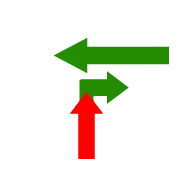 |
Power-driven — crossing (other on your starboard) You give way: alter course to starboard and pass astern of them. (Rule 15) |
 |
Power-driven — crossing (other on your port) You stand on; the other vessel gives way to starboard and passes astern of you. |
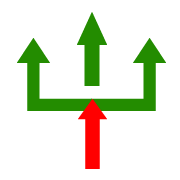 |
Power-driven — overtaking The overtaking vessel always gives way, with a safe and clear maneuver. (Rule 13) |
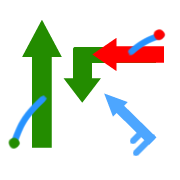 |
Sail vs sail — opposite tacks I have right of way. The port tack vessel gives way (I am on starboard tack). (Rule 12) |
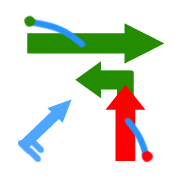 |
Sail vs sail — opposite tacks I do not have right of way. The port tack vessel gives way (I am on port tack). (Rule 12) |
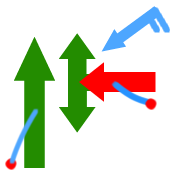 |
Sail vs sail — same tack I have right of way. The windward vessel gives way to the leeward vessel. I am leeward. (Rule 12) |
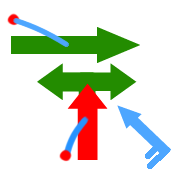 |
Sail vs sail — same tack I do not have right of way. The windward vessel gives way to the leeward vessel. I am windward. (Rule 12) |
Sound Signals at Sea
Convention: • = short blast (~1s) / — = prolonged blast (4–6s).
| Signal | Meaning / When used |
|---|---|
| Maneuvering in Sight (Rule 34) | |
| • | I am altering my course to starboard. |
| •• | I am altering my course to port. |
| ••• | I am operating astern propulsion. |
| ••••• (or more, short bursts) | Doubt / Immediate Danger. I do not understand your maneuver or believe there is a risk of collision. |
| — (at bends or blind corners) | Warning in local limited visibility (e.g., entering a bend/channel). |
| — — • (channel: intention to overtake on starboard) | Narrow Channel (34.c): “I intend to overtake you on your starboard side.” Agreement response: — • — •. |
| — — • • (channel: intention to overtake on port) | Narrow Channel (34.c): “I intend to overtake you on your port side.” Agreement response: — • — •. |
| Restricted Visibility (Rule 35) | |
| — (every ≤ 2 min) | Power-driven vessel making way (underway). |
| — — (every ≤ 2 min) | Power-driven vessel stopped (underway but not making way). |
| — • • (every ≤ 2 min) | Vessel not under power making way (sailing), or fishing, or restricted in ability to maneuver, or not under command, or towing. |
| — • • • (every ≤ 2 min) | Towed vessel with crew on board (if possible), after the tug's signal. |
| ••••• (extra bell) | Pilot vessel on duty: may add ••••• in addition to the above signals. |
| At Anchor / Aground (Rule 35 & 30) | |
| Bell 5s (every ≤ 1 min) | At anchor < 100 m: rapid bell for 5s forward. |
| Bell 5s + Gong 5s | At anchor ≥ 100 m: bell forward and gong aft, both for ~5s. |
| 3 bell strokes + 5s + 3 bell strokes | Aground: before and after the rapid 5s bell, give three distinct strokes. |
| — (in addition to bell) | At anchor (optional): one prolonged blast to warn approaching vessels. |
Note: The overtaking signals in a channel (— — • / — — • • / response — • — •) apply according to Rule 34(c) of the International Regulations. Local variations may exist in inland waterways.
Flags on Board (ICS + Etiquette)
In addition to the flags of the International Code of Signals (ICS) for messages —see table A–Z and 0–9—, boats use flags of nationality, courtesy, and club/owner with internationally standardized locations and sizes.
Order and Location
- National Ensign: at the stern (stern staff). This is the vessel's primary flag.
- Courtesy Flag: of the host country, on the starboard spreader of the mast.
- Club Burgee: at the masthead (if length and instrumentation permit) or on the port spreader.
- "Q" Flag (yellow): when entering a country before customs clearance, on the starboard spreader until formalities are completed.
On vessels without a mast (motorboats), the ensign is at the stern, and others on an auxiliary staff according to the boat's layout.
Guideline Sizes
- National Ensign: height ≈ 1/40–1/50 of the length overall (LOA). Ex: 10m boat → ensign ~20–25cm high (2:3 or 3:5 proportion depending on the country).
- Courtesy Flag: slightly smaller than the ensign (≈ 70–80% of its height).
- Burgee/Club Flag: small size, triangular/rectangular depending on the club's design.
If in doubt, use the rule of thumb: the ensign should be visible and proportional without "dragging".
- Hoisting Times: normally from sunrise to sunset (in port, ceremonial hoisting/lowering at local times).
- Respect: avoid faded/torn flags; do not combine multiple national ensigns.
| Flag | Meaning |
|---|---|
 |
A (Alfa): I have a diver down; keep well clear at slow speed. |
 |
B (Bravo): I am taking in, or discharging, or carrying dangerous goods. |
 |
C (Charlie): Yes / Affirmative. |
 |
D (Delta): Keep clear of me; I am maneuvering with difficulty. |
 |
E (Echo): I am altering my course to starboard. |
 |
F (Foxtrot): I am disabled; communicate with me. |
 |
G (Golf): I require a pilot. |
 |
H (Hotel): I have a pilot on board. |
 |
I (India): I am altering my course to port. |
 |
J (Juliet): I am on fire and have dangerous cargo on board: keep well clear of me. |
 |
K (Kilo): I wish to communicate with you. |
 |
L (Lima): You should stop your vessel instantly. |
 |
M (Mike): My vessel is stopped and making no way through the water. |
 |
N (November): No / Negative. |
 |
O (Oscar): Man overboard. |
 |
P (Papa): All persons should report on board as the vessel is about to proceed to sea (in harbour). |
 |
Q (Quebec): My vessel is "healthy" and I request free pratique. |
 |
R (Romeo): Received. |
 |
S (Sierra): I am operating astern propulsion. |
 |
T (Tango): Keep clear of me; I am engaged in pair trawling. |
 |
U (Uniform): You are running into danger. |
 |
V (Victor): I require assistance. |
 |
W (Whiskey): I require medical assistance. |
 |
X (X-ray): Stop carrying out your intentions and watch for my signals. |
 |
Y (Yankee): I am dragging my anchor. |
 |
Z (Zulu): I require a tug. (Fishing: shooting nets.) |
 |
0: Number zero. |
 |
1: Number one. |
 |
2: Number two. |
 |
3: Number three. |
 |
4: Number four. |
 |
5: Number five. |
 |
6: Number six. |
 |
7: Number seven. |
 |
8: Number eight. |
 |
9: Number nine. |
Morse Code (International)
Morse code represents letters and numbers with dots (·) and dashes (—).
Timing: dot = 1 unit, dash = 3, space between signals in a letter = 1,
between letters = 3, between words = 7. SOS is sent as a single sequence: ···———···.
| Letters A–Z | |
|---|---|
| Letter | Code |
| A | · — |
| B | — · · · |
| C | — · — · |
| D | — · · |
| E | · |
| F | · · — · |
| G | — — · |
| H | · · · · |
| I | · · |
| J | · — — — |
| K | — · — |
| L | · — · · |
| M | — — |
| N | — · |
| O | — — — |
| P | · — — · |
| Q | — — · — |
| R | · — · |
| S | · · · |
| T | — |
| U | · · — |
| V | · · · — |
| W | · — — |
| X | — · · — |
| Y | — · — — |
| Z | — — · · |
| Numbers | |
|---|---|
| Number | Code |
| 0 | — — — — — |
| 1 | · — — — — |
| 2 | · · — — — |
| 3 | · · · — — |
| 4 | · · · · — |
| 5 | · · · · · |
| 6 | — · · · · |
| 7 | — — · · · |
| 8 | — — — · · |
| 9 | — — — — · |
| Punctuation (common) | |
|---|---|
| Sign | Code |
| . | · — · — · — |
| , | — — · · — — |
| ? | · · — — · · |
| / | — · · — · |
| = | — · · · — |
| + | · — · — · |
| - | — · · · · — |
| " | · — · · — · |
| @ | · — — · — · |
Wind – Beaufort Scale
The Beaufort scale classifies wind intensity by its effects on the sea and on land. Useful conversion: 1 kn = 1.852 km/h.
| Force | Description | Wind | Sea State (approx) |
|---|---|---|---|
| 0 | Calm | kn: 0 km/h: 0 |
Sea like a mirror |
| 1 | Light air | kn: 1–3 km/h: 2–5 |
Ripples with the appearance of scales |
| 2 | Light breeze | kn: 4–6 km/h: 7–11 |
Small wavelets, crests not breaking |
| 3 | Gentle breeze | kn: 7–10 km/h: 13–19 |
Large wavelets, crests begin to break |
| 4 | Moderate breeze | kn: 11–16 km/h: 20–30 |
Small waves, becoming longer; frequent white horses |
| 5 | Fresh breeze | kn: 17–21 km/h: 31–39 |
Moderate waves, taking a more pronounced long form; many white horses |
| 6 | Strong breeze | kn: 22–27 km/h: 41–50 |
Large waves begin to form; white foam crests are more extensive |
| 7 | Near gale | kn: 28–33 km/h: 52–61 |
Sea heaps up and white foam from breaking waves begins to be blown in streaks |
| 8 | Gale | kn: 34–40 km/h: 63–74 |
Moderately high waves of greater length; edges of crests break into spindrift |
| 9 | Strong gale | kn: 41–47 km/h: 76–87 |
High waves. Dense streaks of foam along the direction of the wind |
| 10 | Storm | kn: 48–55 km/h: 89–102 |
Very high waves with long overhanging crests. The sea becomes white |
| 11 | Violent storm | kn: 56–63 km/h: 104–117 |
Exceptionally high waves; sea covered with white foam patches |
| 12 | Hurricane | kn: ≥ 64 km/h: ≥ 118 |
The air is filled with foam and spray. Sea completely white with driving spray |
Commonly rounded ranges. Sea state also depends on fetch, current, and bathymetry.

